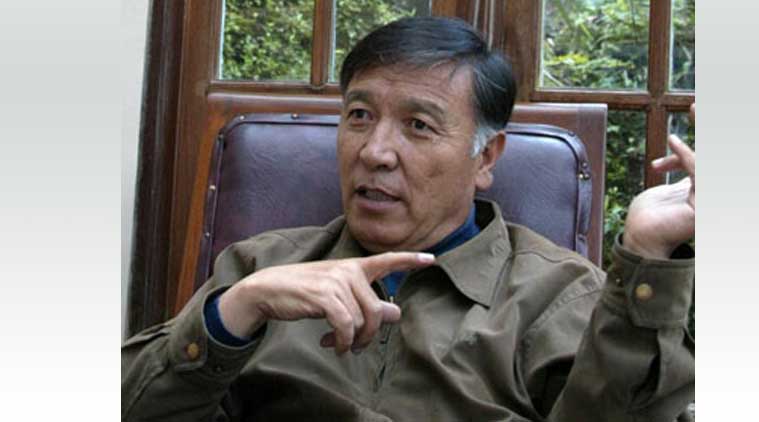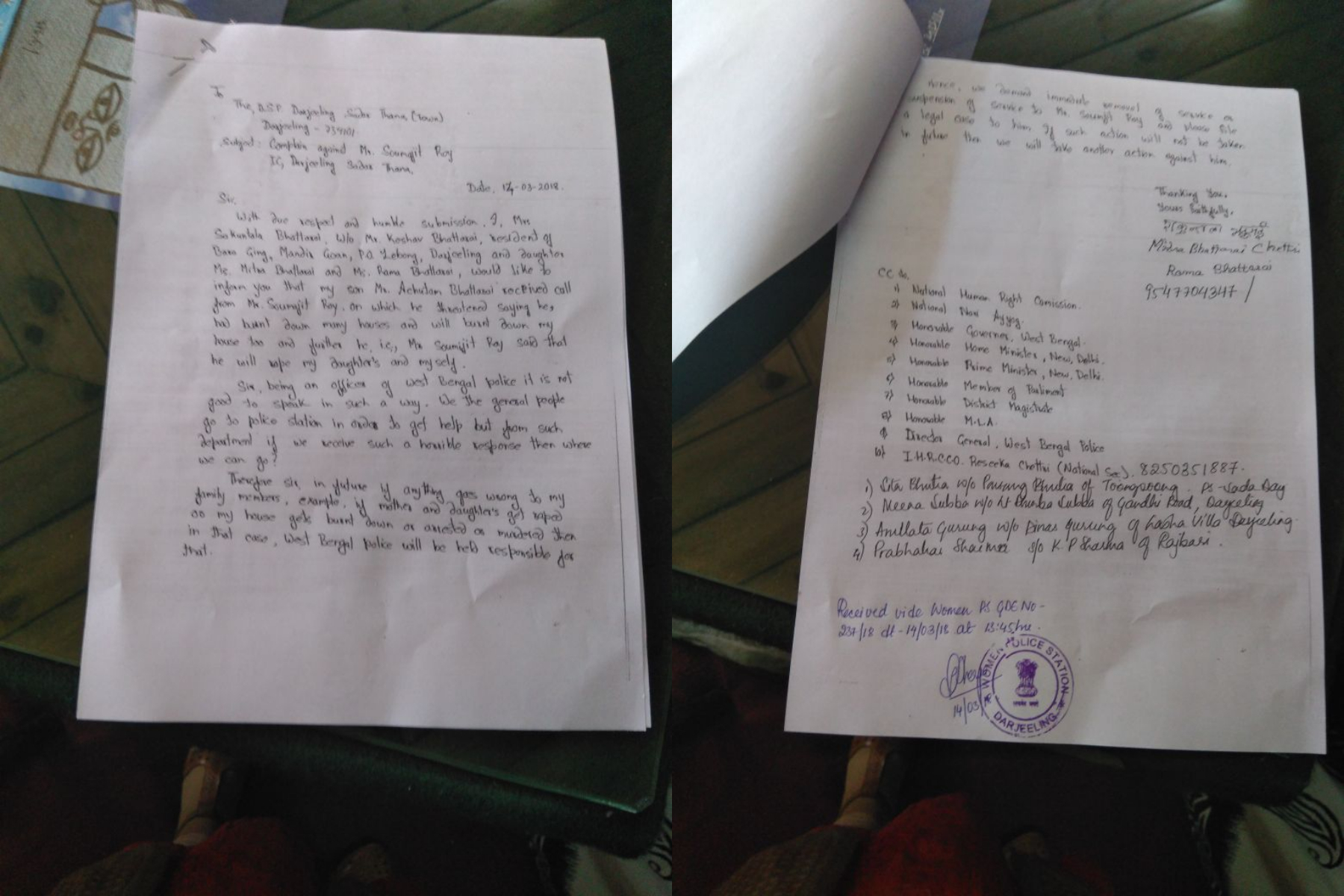This article was originally published in the June 2010 edition of Darjeeling Times magazine, we are reproducing the same in honour of Late. Madan Tamang Ji on his Death Anniversary.
“He represented the best in all of us… he represented what a Gorkhali should be… he represented the fiercenesses… the dedication… the fearlessness… the selflessness… the determination… and loyalty to the cause for which the Gorkhali’s are renowned.” – Pratap Khati.
This past month has been a month of considerable challenge and introspection for the Gorkhalis world over. The assassination of Late Madan Tamang has not only stunned Gorkhalis in India and the Indian media, but it has also generated considerable interest in the media world over. The very foundation of democracy in Darjeeling hills was rocked to the core, and the outpouring of public sentiment against the assassination of Mr. Tamang was not only unexpected but also unprecedented in the history of the area.
A man who could not generate enough public support during his lifetime had finally succeeded in generating public opinion and support against the politics of murder, violence and intimidation with his death. The lone voice against the policies and dictate of the dominant Gorkha Janmukti Morcha (GJM) and earlier Gorkha National Liberation Front (GNLF), Mr. Tamang seems to have succeeded in his death what he failed to achieve in his lifetime – generating public opinion against the dominant party in the Darjeeling hills.
The Man
Very few people knew that Mr. Tamang was born in a cowshed “goth” in Meghma, and often he would jokingly tell those who were curious, that he was born on December 25th. Born as the eldest son to Mr. Manbahadur and Lhamu Tamang (second wife) and fourth eldest (saila) in a family with sixteen children, Mr. Tamang understood responsibility and fraternity from the very childhood. He often stated that his favourite teacher was “Sada Sir” to whom he used to go for tuition during his primary school days. He shared with those who were close to him that perhaps the fact “Sada Sir” gave him “bhuteko makai and chyaa” made him the favourite amongst all the teachers he had in his life.
After completing his schooling in a local primary school in Meghma, Mr. Tamang joined St. Robert’s School in Darjeeling and it was during this period he became engaged in the Bhasha Andolan movement during 1967-68. As shared with his close associates, Mr. Tamang used to volunteer propping posters across the town in favor of Nepali Bhasha Manyata on his way to school. After completing school he joined St. Joseph’s college and was elected as a student counselor. Mr. R. C. Poudel of Sikkim, Mr. Nir Shah (Nepali actor) etc. were his batch mates. It was revealed to this correspondent that Mr. Tamang was quiet fond of singing and would often participate in the college cultural fests, and Mr. Nir Shah would accompany Mr. Tamang with the madal. A vocal supporter of education amongst the youth, it was however ironic that, Mr. Tamang never bothered to collect his graduation degree from the college.
To those who knew him closely Mr. Tamang was Madan Daju, a simple, humble and down to earth person. A person of extraordinary warmth and compassion, many of those whom he had helped during their hours of need held him in the very highest esteem. “Mo ta singaney keta aako nee bhai… daju naa bhayeko bhaye kee chai GNLF ko gunda hunthye hola… kee chai DGHC ko contractor… Daju ley garda nai mo manchey bhaako”… lamented Mr. Pratap Khati a successful lawyer from Kalimpong and the President of Tarun Gorkha (ABGL Youth Wing). A former Bhutanese refugee who is now settled in USA stated that Mr. Tamang had not only helped him financially but also acted as his mentor and guardian during his stay and study in Darjeeling, “Daju ley kahiley chaina, hundaina, pugdaina bhannu bhayena…aafnai bhai jasto treat garnu hunthyo hami sabai lai. Ma matrai haina daju ley Bhutan bata aayeko dherai manchey haru lai sahayog garnu bhayeko thiyo.”
An avid gardener, his love for the diverse flora of the Himalayas was well known. He particularly loved Rhododendrons (Guras) and in fact had planted a whole hillside (over three lakh plants) of them in Meghma. He also planted over sixty varieties of Guras at his home near Batasey. Mr.Victor Banerjee, a famous Kolkata based actor and a close friend of many years wrote in his obituary, “To travel into the interiors of Bhutan and Sikkim and sweat for years to acclimatize rhododendron bushes to the altitude and climate of Darjeeling was one man’s dream, one man’s achievement.”
“Personally, Mr. Tamang was a very simple man with simple needs”, asserted Mrs. Bharati Tamang in a recent interview with the Darjeeling Times. “He was fond of books. He bought books from every place he visited. He has a huge number of books on various subjects of his interest. A loyal husband, he was always ready to help, I never thought about procuring house hold matters. We hardly had any quarrels and he was always very understanding. He used to serve tea every morning… Can you believe, he would help with the domestic chores including cleaning of bathroom, serving food to dogs etc.” Mr. Pratap Khati who was like a son to Mr. Tamang informed this correspondent that Mr. Tamang even served bed tea to the guests at his home.
“Mr. Madan Tamang was as misunderstood by the general public as he was revered by those who knew him intimately” says an individual who was close to him. More often than not Mr. Tamang came across as somewhat “snotty,” “patronizing” and “arrogant,” stated a local political figure, which goes totally against the character of a person who would always call back if there was a missed call on his cell phone. “He never missed birthdays and important occasions of those who were close to him. It is incredibly sad that he was murdered on the birthday of his son (Mr. Sanjog Tamang)” said a person very close to the Tamang family.
His politics
Late Madan Tamang was attracted to politics at a very young age. While studying at St. Robert’s in Darjeeling, Mr. Tamang used to volunteer putting up posters in support of Bhasha Andolan while on his way to school. On completion of his schooling at St. Robert’s, Mr. Tamang plunged into politics and joined the Akhil Bharatiya Gorkha League (ABGL) under the then charismatic leader Deo Prakash Rai. During the 1970s, Madan Tamang headed Tarun Gorkha, the youth wing of the ABGL and immediately shot into the limelight with his oratory skills. He was made the district secretary of the ABGL in 1977, but resigned in 1980 due to the difference in opinion with the senior leadership of the party.
The same year he joined a new outfit called Pranta Parishad and spearheaded a campaign along with other apolitical organizations like the Nepali Bhasa Manyata Samiti to include the Nepali language in the Eight Schedule of the Constitution. Tamang also worked closely with Subash Ghising during the initial days of Pranta Parishad Incidentally, Madan Tamang was the first person to be arrested for the Gorkhaland cause.
Ghising later on floated the GNLF and slowly started overshadowing the Parishad with the statehood demand. By 1986, the entire hills were with Ghising but Tamang refused to join him as he fundamentally differed from Ghishing in the use of violence as a means of achieving statehood. Even at the height of the Gorkhaland agitation between 1986 and 1988, Tamang never stopped criticizing Ghising and the violence the GNLF had unleashed in the hills. During those times, Tamang was the only visible individual who spoke fearlessly against the GNLF while still residing in the hills.
In 1992, Tamang floated the Gorkha Democratic Front (GDF) when the GNLF started opposing the inclusion of the “Nepali” language in the Constitution. The GNLF wanted the nomenclature to be changed from ‘Nepali’ to ‘Gorkhali’ during the incorporation of the language in the Constitution. While addressing a public meeting at Chowk Bazaar, hordes of khukuri wielding GNLF supporters approached him threateningly but he stood his ground and continued with his speech. Finally, the language was incorporated as Nepali/Gorkhali in the Constitution. After his success with the Nepali language agitation, Tamang laid low for a while until 2004 when he joined the ABGL again.
Madan Tamang not only fought for the Gorkhali cause in India, but was also concerned for Gorkhalis everywhere. This was evident when he participated in the Mechi peace march with Bhutanese refugees (Lhotsampas) while leaders of the stature of Ghising, Bhandari, Chamling and Koirala looked the other way. In his obituary Mr. Hari Adhikari (a Bhutanese refugee now based in USA) wrote, “… it is difficult to believe the news of the death of a person who was always there for you in any situation—be it personal, family, social or national.” Durga Giri (another Bhutanese refugee) joined in the sentiment and wrote“…it is a very unfortunate happening. It is true that he was “Madan daju” for many Bhutanese. He was one of our greatest well-wishers, supporter of the Bhutanese refugees for their right to return and for democracy in Bhutan. His broad day light killing is the murder of democracy in the hills of Darjeeling. We join our sentiment to condemn this gruesome act.”
Tamang was the first leader to raise his voice against the corruption within the Darjeeling Gorkha Hill Council and later the Sixth Schedule championed by the GNLF. He defied GNLF-sponsored strikes to address public meetings against the inclusion of the hills in the Sixth Schedule of the Constitution. His vehicle was attacked in Kalimpong, his meeting was stoned in Bijanbari but he never lived in fear but instead formed and headed an anti-Ghising group called the People’s Democratic Front. PDF was instrumental in getting Mr. Dawa Narbula elected as the Member of Parliament from the Darjeeling constituency. R. B. Rai the CPRM leader attributes to Madan Tamang the laying of the foundation for the ouster of Subash Ghising from power.
Madan Tamang researched on a subject intensely before forming his opinion and this served him well when he went to Delhi to present the case against the inclusion of Darjeeling Hills in the Scheduled Sixth of the Indian Constitution. His testimony before the Parliamentary Standing Committee, which lasted for almost an hour impressed the committee members so much that Mr. Lal Krishna Advani said, “Mr. Tamang we need to meet again, I am very impressed,” recalled Mr. Khati who had accompanied Mr. Tamang to Delhi.
“When the Gorkha Janmukti Morcha was formed in 2007, he initially supported the new party. But the modus operandi of GJM was identical to that of GNLF and that was totally unacceptable to Madan Tamang who had opposed the GNLF on the very grounds of threat, intimidation and dictatorship” said a political analyst. His vocal opposition of Morcha activities led to attacks on his house, his vehicle and the party office. He was even prevented from holding public meetings in Darjeeling, but nothing could stop him from voicing his views. Taking advantage of technology, he started using the internet and sites like Youtube to get his views across th the public.
Madan Tamang’s dream was to see the formation of a separate state of Gorkhaland, and he was the only person to warn the people of Darjeeling Hills against GJM selling out to the state government by accepting an interim set-up instead of Gorkhaland (which the GJM acknowledged at a later point in time). “This was the reason why he was not allowed to speak in public by the GJM. They feared him, and that’s why they had to silence him,” said a senior politician.
His Assassination
The threat to Madan Tamang’s life was so omnipresent that it was rather mundane and routine for him and his close associates. In fact he strongly held the notion that noone from the Darjeeling hills would ever harm him. Recalls Mr. Khati, “malai Darjeeling ko maanchey ley hela garlaa… tara marnu chai mardaina” is what he used to tell his fellow party workers. It is indeed sad that he was supposed to go for a Europe tour on the 1st of June but he had decided to cancel his tour at the request of his party since they feared that the state and the central government would pass the interim set-up bill in his absence. Many inside the party lament that had he not been persuaded to cancel his tour, he might have been alive today.
On May 21st, around 9:15am, he reached the Club Side near Keventers to address the ABGL Foundation Day rally, which had already been postponed once due to the GJM women’s wing not allowing ABGL to convene the meeting in Chowk Bazar.
At around 9:30 a mob of around 100 to 150 people descended on the ABGL meeting venue from Chowrasta and in view of the entire Darjeeling based media and around 40 armed police personnel, Madan Tamang was hacked to death.
The Aftermath
The assassination of Madan Tamang sent shockwaves across the political spectrum not only in Darjeeling but across India. Scenes of his lifeless body being held by his driver were flashed across the national media and within moments of the incident, messages of outrage flowed in from across the globe. The needle of suspicion directly pointed towards the GJM which denied its involvement vehemently. Nevertheless, the reaction to the broad daylight murder of one of the most vocal proponent of Gorkhaland was not only unprecedented but also totally unanticipated.
Business establishments downed their shutters, schools closed their gates, and vehicles did not ply on the road. The GJM trying to portray an air of normality and initially ordered and later pleaded with people to open their businesses and ply their vehicles on road . But in an open act of defiance, people kept the town completely shut down till Madan Tamang’s funeral.
Citizens of the town could not bear to see the politics of violence dominating the hills and they sent out messages over the phone, requesting people to show their support against the murder of Madan Tamang by attending a peace “candle light” rally. What started as a small group people protesting against the murder, turned into an open platform for people to show their defiance and anger at the GJM. The first candlelight rally spurred another two more and each time the rally went on to become larger and was joined by a wide spectrum of people.
For the first time since the beginning of the first Andolan, had Darjeeling witnessed such a spontaneous gathering of people. People from all walks of life, the young and old, men and women marched together, many chanting prayers but most walking silently. It was this silence that resonated the loudest. In Darjeeling, candlelight rallies were organized in places like Ghoom-Jorebunglow, Sonada, Sukhia, Kurseong, Mirik and Kalimpong.
The show of solidarity and protest were not only confined to the hills, but they spread like wild fire across India. The Darjeeling Student’s Association (DSA) organized a peace rally in Kolkata, followed by protests and peace rallies in Delhi, Mumbai and Bangalore. It is to be noted that these rallies were spontaneously held without any organizations or political parties prompting it.
The entire Darjeeling related blogosphere was on fire, with comments coming from around the world where ever Gorkhalis resided. The comments were not only directed towards GJM but also towards the state government, which many people believe was hand in glove with the GJM. It has been speculated in various circles that the state government allowed this murder to happen because this gives them an upper hand over the GJM in its negotiations for an interim-set up.
However the ultimate defiance against GJM was displayed on the funeral day. Over 15000 people braved heavy rains and crowded the streets of Darjeeling to pay tribute to the slain leader. It was a sight which Darjeeling has rarely witnessed. The funeral procession soon turned into an anti-GJM rally with people shouting anti-GJM and anti-Bimal Gurung slogans. GJM flag was torn and so was Bimal Gurung’s poster. It was for the first time since the formation of GJM did people raise their voice against GJM openly. People had lined up all the way from Darjeeling to Ghoom and from Sukhia to Maneybhanjyang to show their respect to the slain leader.
The Resignations
This unprecedented outpouring of emotions directed towards the GJM, ultimately caused the entire GJM leadership to leave Darjeeling on May 23rd for Kalimpong. GJM chief Bimal Gurung blamed everyone from the state government to the Maoists in Nepal for the killing of Madan Tamang. The vehement denial of any involvement by the GJM was completely disregarded and it was made apparent whom the general public saw as the culprits.
Encouraged by the public outpouring of colossal proportions, Mr. Anmole Prasad a prominent GJM leader from Kalimpong was the first to resign from the GJM citing moral responsibility for the murder of Madan Tamang as the cause. This opened a floodgate and many other prominent GJM leaders resigned . The resignation of Trilok Dewan, Dr. Harka Bahadur Chettri, Amar Singh Rai, L. B. Pariyar, Amar Lama had brought GJM on the verge of collapse.
However this drama was far from over. The very next day after resigning Dr. H. B. Chettri took back his resignation. It is rumored that Dr.Chettri was dragged from his house and brought before the Morcha chief in his shorts. This was followed by Mr. Amar Singh Rai, Mr. Trilok Dewan taking back their resignations. Undoubtedly the pressure exerted by GJM on these very public figures was apparent.
The Ghoom Rebellion
Worried that its fate would be similar to that of the GNLF and its leader Subash Ghising if it kept quiet and did not stop the voice of dissent from growing louder, the GJM leadership in general and Bimal Gurung in particular returned to Darjeeling. On May 25th, He came with a convoy of over 100 vehicles, heavily guarded by his contingent of self-raised security guards – the GLP who were armed to the teeth.
When the convoy reached Ghoom, they were met with protests and the protesters laid themselves on the ground in order to prevent Bimal Gurung from entering the Darjeeling town. The protesters especially women seemed very determined and they openly challenged the might of GJM and GLP. It was only with the help of the police force was Bimal Gurung able to enter the Darjeeling.
This rebellion proved that people had not only lost complete faith in the GJM, but were willing to openly challenge them. Despite the fact that Section 144 was clamped in the town and Bimal Gurung and other GJM leaders travelling with him were booked under section 302 of the IPC, the administration helped GJM leaders to enter the town with armed security guards. Bimal Gurung also held a public rally on the same day. All this further strengthened the doubt in people’s mind that the state government had a hand in Madan Tamang’s murder.
Those Accused
Following the assassination, ABGL general secretary Laxman Pradhan lodged an FIR against the GJM top brass. In the FIR he had named Bimal Gurung, his wife, Asha, GJM general secretary Roshan Giri, GJM central committee members Harka Bahadur Chhetri, Pradeep Pradhan and Benoy Tamang, and Gorkhaland Personnel (GLP) chief Col (Rtd) Ramesh Allay as “conspirators.” In the FIR, Pradhan also named GJM’s sub-divisional leaders, Dinesh Gurung, Puran Thami and Tenzing Khambachay, Gorkha Janmukti Yuva Morcha chief Alok Kant Thulung and Gorkha Janmukti Vidyarthi Morcha leaders, Kismat Chhetri and Keshavraj Pokhrel as the ones who carried out the murder.
“We’ve registered cases under Sections 120B and 302 of IPC against the persons named in the FIR,” said the then North Bengal IGP Kundan Lal Tamta. However, none of those named in the FIR have been arrested so far. Despite filing the case under section 120B and 302 of IPC Bimal Gurung, Asha Gurung, Roshan Giri etc. continue to be guarded round the clock by body guards provided by the state government.
Those arrested
Investigations are currently being undertaken by the Criminal Investigation Department (CID) of the West Bengal Police. The CID has so far arrested Subash Tamang and Prashant Chhetri from the North Bengal Medical College and Hospital on June 4 These two were injured by the bullet fired by Mr. Lachman Pradhan’s body guards on May 21st. On the same day, they also picked up Sudesh Raimaji, a contractor from Darjeeling. The chief judicial magistrate’s court has sent Raimaji to judicial custody and the next date for hearing has been fixed on June 28. Raimaji had been sent to a 10-day police remand after his arrest.
In addition, the CID have also tagged Puran Rai, Ashish Tamang, Sunil Rai, and Tilak Sotang in the murder of Madan Tamang.
The main accused which includes Dinesh Gurung, Puran Thami, Tenzing Khambachay, and Alok Kantmani Thulung are still at large and the CID had hinted at issuing a red corner notice to the INTERPOL for their arrest. Some of these accused are currently believed to be in Nepal and some in Sikkim.
A name that has prominently featured in the recent investigations is that of Nichol Tamang; a person who is believed to be a very close associate of Morcha chief Bimal Gurung. The police have stated that his cell phone was found at the murder site. Nichol Tamang is also absconding.
Aftermath to the Aftermath
The GJM changed the nomenclature for the demand of the Gorkhaland to Gorkhaland Adivasi Pradesh (GAP) in order to include the Adivasis of the Doors and Terai region. The Adivasis in turn have so far not shown any interest and their central leadership declined the offer to fight for a unified Gorkh-Adivasi Pradesh outright. The GJM in protest had called for an indefinite strike only to take it back once again, clearly indicating that the Morcha is on the back foot. Political analysts believe the name change and the call for a strike are to let public passions cool down and also to divert the attention from the murder investigations.
Mrs. Bharati Tamang (the wife of Madan Tamang) was unanimously elected as the President of ABGL and she has vowed to continue fighting for Gorkhaland and seek the culprit of her husband’s killers. She met the Chief Minister on the 23rd of June and the CM has assured her of all possible help and complete cooperation from the administration with regard to murder investigations.
Sensing the public outcry and being rebuked by the Governor who was “shocked and dismayed” by this gruesome act, the state government is showing a semblance of taking some action.
As of today, the police department forced the GLPs to vacate DGHC guest houses in Pedong, Reling and Delo — all in the Kalimpong sub-division — which they have been occupying for the last two years. They have said they will make the GLP vacate from all the lodges.
The people have already started to speculate – like many previous political assassinations that went unsolved- this one might also go unpunished. It is indeed tragic that the most vocal proponent of Gorkhaland was murdered in the broad day light for voicing his support for Gorkhaland and nothing else.
The ounce of governing, now lies with the government, which has been conspicuously absent from the beautiful Darjeeling Hills for over twenty four years now.
It could be symbolic that the assassination of Rajiv Gandhi on the same date (May 21st) spelled doom for the LTTE in Sri Lanka, which ultimately led to their demise. Perhaps the death of Madan Tamang may well become the turning point in the struggle for Gorkhaland and for the restoration of peace, democracy and prosperity in the Darjeeling region.
……………….
Justice is still awaited in this heinou day-light murder of a Gorkha son.
For analysis on how the Prime accused in Madan Tamang murder case Nicol Tamang went missing, the please visit: https://www.facebook.com/notes/the-darjeeling-chronicle/the-curious-case-of-nicol-tamang/555979011206551/






Be the first to comment on "REMEMBERING MADAN TAMANG"